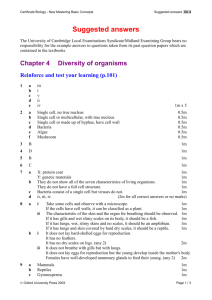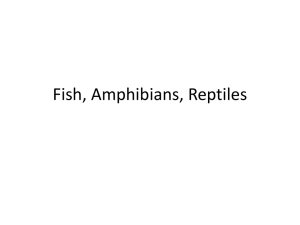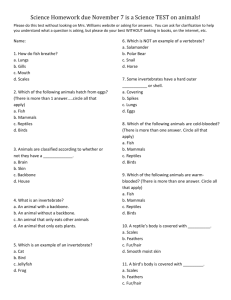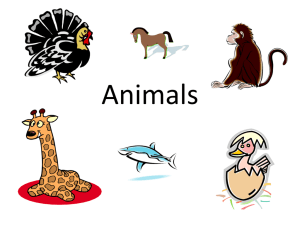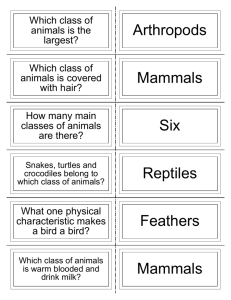Chordate Notes - Fulton County Schools
advertisement
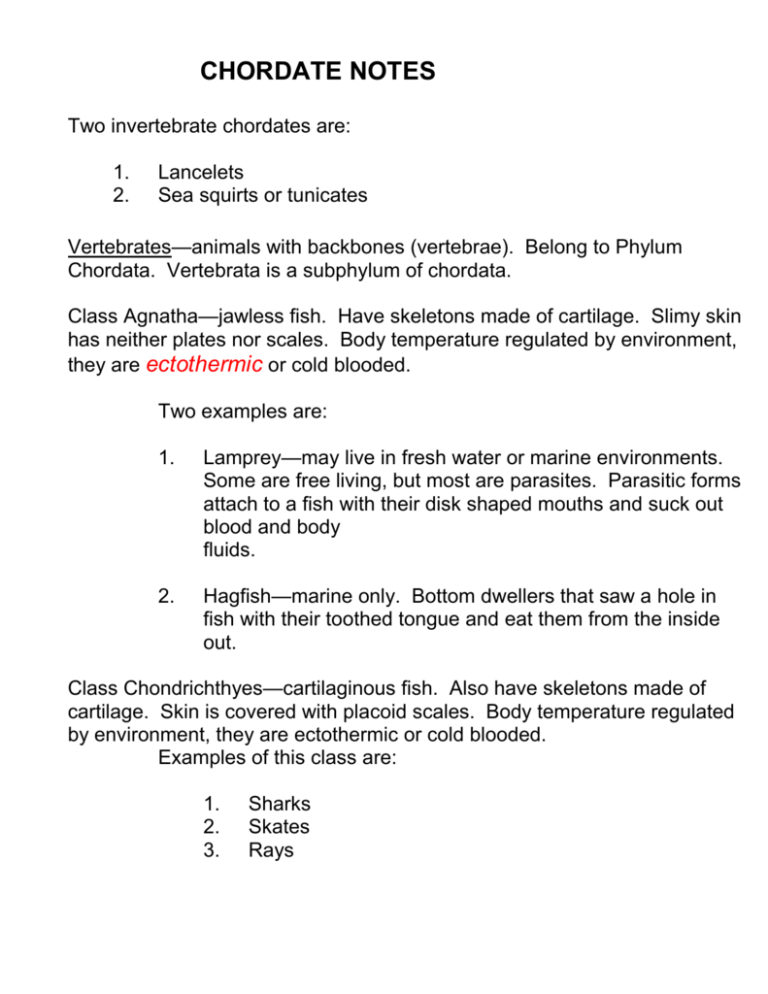
CHORDATE NOTES Two invertebrate chordates are: 1. 2. Lancelets Sea squirts or tunicates Vertebrates—animals with backbones (vertebrae). Belong to Phylum Chordata. Vertebrata is a subphylum of chordata. Class Agnatha—jawless fish. Have skeletons made of cartilage. Slimy skin has neither plates nor scales. Body temperature regulated by environment, they are ectothermic or cold blooded. Two examples are: 1. Lamprey—may live in fresh water or marine environments. Some are free living, but most are parasites. Parasitic forms attach to a fish with their disk shaped mouths and suck out blood and body fluids. 2. Hagfish—marine only. Bottom dwellers that saw a hole in fish with their toothed tongue and eat them from the inside out. Class Chondrichthyes—cartilaginous fish. Also have skeletons made of cartilage. Skin is covered with placoid scales. Body temperature regulated by environment, they are ectothermic or cold blooded. Examples of this class are: 1. 2. 3. Sharks Skates Rays Class Osteichthyes—bony fish. Skeletons made of bone. Make up most of the vertebrate population of fresh and salt water. Skin may have scales, or the fish may be scale-less (trout & catfish). Body temperature regulated by environment, they are ectothermic or cold blooded. Class Amphibia—amphibians. Name comes from a Greek term meaning “double life”. Characteristics include: 1. Metamorphosis—change from an aquatic larval stage to a terrestrial adult form. 2. Have moist, smooth, thin skin with no scales. 3. Feet (if present) are webbed. 4. Use gills, lungs, skin, and mouth cavity to absorb oxygen during external respiration. 5. Larvae have two chambered hearts; adults have three chambered hearts and well developed circulation. 6. Eggs lack multicellular membranes or shells. Usually laid in water or a moist environment and fertilized externally. 7. Body temperature regulated by environment, they are ectothermic or cold blooded. Examples of this class include: 1. Frogs and toads—frogs have smooth, moist skin and short, broad bodies. Toads have dry, bumpy skin, a stocky body, and short legs. Toads are well adapted to life in dry environments. Larval forms called tadpoles. 2. Salamanders—have elongated bodies, long tails, and smooth, moist skin. Less adapted to dry land than frogs and toads. Some have a type of internal fertilization. 3. Caecilians—tropical burrowing amphibians. Legless wormlike creatures averaging 30 cm long, but they may be up to 1.3 m long. 4. Mud eels or sirens—live in eastern US and northern Mexico. Have minute forelimbs but no hind limbs. Class Reptilia—reptiles. Characteristics include: 1. Amniote egg—egg with a protective membrane and a porous shell to protect the developing embryo. 2. Waterproof skin of horny scales or plates, develops as surface scales fill with keratin (protein that forms nails and hair in humans). Reptiles must shed their skin, or molt, in order to grow. 3. All breath air through lungs. 4. Most species have a three-chambered heart. Crocodiles and alligators have a four-chambered heart. 5. Land dwelling reptiles excrete nitrogenous waste in the dry or pasty form of uric acid. 6. Body temperature determined by their environment, therefore they are said to be ectothermic. Examples: 1. 2. 3. 4. 5. Dinosaurs—refers to a group of now extinct reptiles. Turtles and tortoises Lizards Snakes Alligators and crocodiles Class Aves—birds. Characteristics: 1. Feathers—may be down feathers, contour feathers, flight feathers, or filoplumes. Feathers are thought to be modified scales. Birds also periodically molt their feathers. 2. Have toothless, horny beaks—structure is related to function in beaks. 3. Bones are thin and hollow. 4. Amniote eggs encased in hard, calcium containing shells. 5. Body temperature is regulated internally, they are said to be endothermic or warm blooded. 6. Two forelimbs modified for flight in most species, and two clawed hind limbs for support. Examples include hawks, finches, sparrows, owls, ostriches, emus, vultures, penguins, and many other forms. Class Mammalia—mammals. Characteristics: 1. Endothermic or warm blooded. 2. Have hair 3. 4. Heart has four chambers Muscle (diaphragm) that aids breathing present 5. Have a single lower jawbone, and most species have four different types of teeth 6. Most species are viviparous, that is they bear their young alive and are called placental mammals. 7. Many have a highly developed brain 8. Females secrete milk from mammary glands to feed their young Monotremes—mammals that lay eggs (not placental mammals). Include the duck-billed platypus and the spiny anteater. Live in Australia, Tasmania, and New Guinea. Marsupials—give birth to tiny, immature young that crawl into a pouch on their mother’s belly immediately after they are born. Examples include opossums, kangaroos, wombats (found in Australia and resembles a groundhog), flying phalanger (found in Australia and resembles a squirrel), and the cuscus a type of monkey native to Australia. Ninety-five (95) percent of all mammals are called placental mammals. They carry their unborn young in the female’s uterus until the young are able to survive in the outside world.

